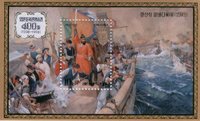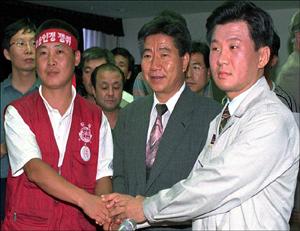Having failed to gain political and security concessions from the United States with the 2003 nuclear crisis, North Korea has decided to dust off its playbook from 1997/1998.
2003 Crisis: A Script From a Different Day
The 2003 nuclear crisis was planned in 2000 and deployed in October 2002. It was designed to scare the US into signing security agreements with North Korea, and perhaps even open the Armistice talks again to pave the way for a formal peace accord. The North Koreans chose 2003 for several reasons, but one key symbolic aspect was the 50th anniversary of the 1953 armistice. In
typical North Korean fashion, the plan was to warn of a series of escalating steps (restarting nuclear program, pulling out of NPT, etc) and then begin following through with these steps until the US was so afraid of the next step that it would negotiate down the "crisis."
North Korea made one major miscalculation, however. The plan was constructed in late 2000 and early 2001, but was not altered after the Sept. 11 attacks on New York and Washington DC. When October 2002 rolled around, North Korea failed to recognize the change in U.S. strategic attitude. Washington would no longer tolerate such North Korean games, or potential threats, in a world where the mainland U.S. was suddenly exposed as being vulnerable. Perhaps Pyongyang figured that Washington was so pre-occupied with the "
GWOT" (Global War On Terrorism) that it would be so concerned about a new North Korean front opening that Washington would capitulate to Pyongyang's demands.
If that was the case, Pyongyang really failed to understand the shift in U.S. strategic thinking at the time. In fact, there are some indications that, as Washington chose to ignore rather than engage North Korea, Pyongyang's overseas "advisors" at places like the
CFKAP were chastised and cut out of the loop of strategic planning for a while. The main problem with North Korea's planning, as usual, was its rigidity. Pyongyang is meticulous at planning, but not very capable of rapid shifts when things don’t match the plan perfectly. North Korea is infamous for pre-planning the times to storm out of negotiating sessions, no matter the pace of said sessions. Creative thinking and freedom of action are relatively foreign concepts.
The 2003 model has failed to give North Korea its intended benefits. It has offered secondary gains – particularly in the ever-more-obvious rifts between Washington and Seoul. But the security guarantees never materialized, the peace accord was never signed, and North Korea remained isolated in a box shaped by the United States. Over the past several months, North Korea has finally reshaped its plans, and it is looking like those are much more akin to the 1997/1998 "crisis" plans that seemed to have worked so well for Pyongyang.
1997 Strategy: Shaping Impressions, Exploiting Fear
When North Korea hauled the Taepodong-2 out of storage, propped it up on the launch pad, and ignored pleas to refrain from a new long-range missile test, it became apparent that Pyongyang was shifting back to what it sees as a tried and true negotiating strategy. In the weeks following the launch, North Korean actions and the associated media coverage (particularly from Japan) have reinforced this idea.
The 1997/1998 crisis was a combination nuclear and missile crisis, coupled with concerns for the stability and sanity of the North Korean regime, all compounded by a massive humanitarian crisis. The basic premise of North Korean strategy was simple.
First, create a security crisis. The combination of a renewed nuclear crisis with a long-range missile crisis played on the fears of North Korea’s neighbors and the United States. That guaranteed attention. Attention was necessary to issue demands.
Second, encourage the sense of unpredictability. North Korea thrived on the image of unpredictability. The North did little to weaken South Korean intelligence propaganda portraying Kim Jong Il as a crazy drunk womanizer who fell off his horse and went wacky in the head. This let people underestimate North Korea, but also fear crazy actions. If Pyongyang was not seen as a rational player, then it was clearly playing by a different set of rules. This gave Pyongyang he ability to set the agenda.
Third, present a sense of regime instability. In 1997 and 1998, Kim Jong Il was completing the process of consolidating his hold on power following the 1994 death of his father, Kim Il Sung. This wasn’t a simple process, but it wasn't nearly as hard fought as South Korean intelligence made out at the time. The impression North Korea cultivated was that the regime was split, that there were factional divides, that there were the feared "hardliner" elements who wanted to launch a new regional war. This made it imperative that foreign governments, like the United States and regional neighbors Japan, China and South Korea, try to work with the emerging regime to prevent the rise of hardliners. Any action that further destabilized the North Korean regime or gave "justification" to the hardliners' arguments was seen as counterproductive.
Fourth, compound the sense of impending doom by emphasizing a social crisis. The famine of the mid 1990s was the catalyst that would supposedly trigger social backlash, cause the regime to clamp down even harder, bring the hardliners to the top, and trigger a regional or global conflagration. While there was a food shortage, and it was not a pleasant time in North Korea, the international claims were often an exaggeration of the true state of affairs, based on extrapolating to the entire nation the impressions of a select few defectors from the worst hit northern regions, where the politically unreliable are concentrated. And Pyongyang did nothing to dissuade the observers of their views that the famine was widespread and on the verge of bringing collapse to the country.
This four-part strategy is once again being repeated.
2006/2007: 1997/1998 Redux
The July 5 missile launch has once again raised the North Korean issue to the top of many international agendas. Despite the failure of the Taepodong-2, the North Koreans have once again combined a nuclear and missile crisis, raising cries that Pyongyang may be able to nuke Los Angeles. The military threat is there once again. Reports of North Korea being on a wartime footing have spread. Pyongyang has recalled its ambassadorial staff. North Korean rhetoric is on the rise. Talk of enhancing the deterrent capability fill the North Korean press.
Step two; unpredictability. North Korea launched its missiles, despite the international community urging it not to. In particular is the impression that North Korea has gone against the wishes of its main sponsor, China. There are stories all over the place of a rift between Pyongyang and Beijing over trains and missiles. These stories contribute to the sense that North Korea is crazy, unpredictable, and not playing by the same set of rules one would expect. Add in reports of Kim Jong Il's new wife (apparently a former secretary) and we start to see the patterns of the past emerge. Step two accomplished.
Step three, create a sense of instability. North Korea's UN diplomats were quick to tell the Japanese after the missile tests that the diplomats didn't know what the military was doing. This has circulated and expanded into reports that there are massive rifts inside the North Korean regime; fights over the missile launches and North Korean policy. Kim Jong Il hasn't been seen since the test, and was conspicuously absent from ceremonies marking the anniversary of the passing of his father. Oh, and for good measure, suddenly cut off economic ties with South Korea. Who would have seen that coming? Step three complete.
Step four; social crisis. Mother Nature helped out once again, as floods in the North "killed hundreds" and quickly led to warnings that a new famine was in the offing.
So North Korea is threatening again, the regime is unpredictable again, there are internal rifts again, and a social and humanitarian crisis is brewing again.
Convenient.
Japan; Center of Disinformation?
It is interesting to note that nearly all the information concerning each of these internal problems originates in Japan. On the one hand, Japan has an interest in playing up the North Korean threat for domestic reasons. Koizumi is working hard to enhance his military, to bring the public around to joining his call for Constitutional reform of Article 9.
But there is something else at work. North Korea has a large sympathetic ethnic Korean population in Japan, and this serves as the source of much of the disinformation, rumors and innuendos that spread out as "insider" information into internal North Korean troubles. With Japan's desire to paint North Korea as evil and crazy, it soaks up these reports, some true, others exaggerations, and spreads them out to the world. Just as Washington ate up the "intelligence" from Chalabi before the start of the Iraq war, Japanese media and intelligence is eating up the North Korean information because it matches what Tokyo wants to see.
And so we have North Korea shaping the international impressions, and building toward a repeat of the 1997/1998 crisis. The resolution of that one ultimately led to the 2000 inter-Korean summit, the visit to Pyongyang of Madeleine Albright and the opening of North Korean diplomatic ties with half of Europe, Australia and Canada. From a North Korean perspective, that one worked well. Now, we will see if it can be repeated.








